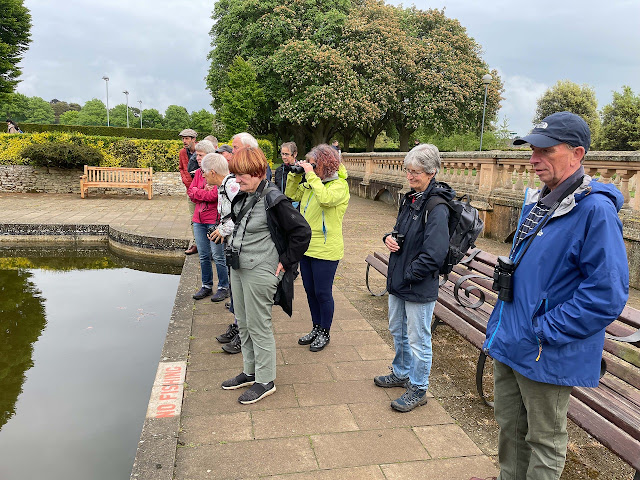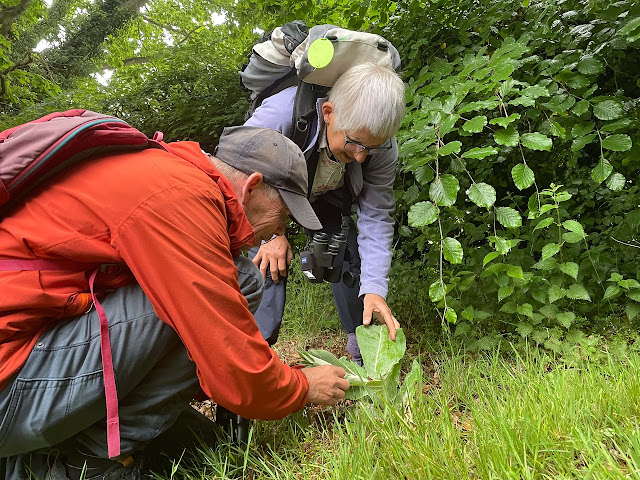The
first local Honeyguide trip since overseas holidays resumed was planned with an
eye on a sunny weather forecast, though as today approached that changed. It
was cool at first then rain arrived for the four of us who met at NWT Hickling.
On
a recent visit to Hickling, Helen and Malcolm had encountered cranes and that persuaded
us to return here, and to go in their direction when we arrived. That took us
along the path by Brendan’s Marsh, where the mix of waders was very impressive.
Avocets, redshank and lapwings were to be expected. Half a dozen dunlins were
nice as was a single greenshank; a grey plover in full summer plumage showed
why in North America they are known as black-bellied plover. A little ringer
plover repeatedly flew around and there were three male ruffs with white, black
and rufous breeding plumage.
 |
| Two cranes beyond the gate; greylag & Canada geese, cormorants and gadwalls nearer. |
Looking
down the open area just beyond the end of Brendan’s Marsh we struck lucky, as a
family of cranes was in the open beyond a metal gate. As well as two adults
there were two young cranes, in the colour that prompted the late John Buxton at
Horsey to call them ‘goldies’, though the young birds were mostly out of sight
in long vegetation. There was added drama when a fox appeared on our side of
the gate. Foxes are predators of young cranes, so it was surprising to see how
unanimated the adults seem to be, as they must have known it was there.
It
became cooler and by a ditch we found various damselflies settling onto reeds,
namely azure, variable and blue-tailed. Closer still was a fabulous
four-spotted chaser. If you look all their wings, should they be called eight-spotted
chaser?
 |
| Four-spotted chaser. |
Seven
black-tailed godwits flew through and when we reached the visitor centre end of
Brendan’s Marsh there was a flock of 18. A small group of ringed plovers flew
in: it’s not often you see ringed plover and little ringed plover in the same place.
By
now it was raining properly, and we sheltered and had coffee in or by the
visitor centre. A female hairy dragonfly was trapped on the inside of a very
high window: the visitor centre team were still puzzling over how best to
rescue it later.
We
decided to brave the rain and walk the circuit around the reserve, taking
advantage of hides. From the first there was a Chinese water deer and we saw nesting
black-headed gulls get agitated whenever a feeding little egret was too near. A cuckoo was calling and we could see it on a distant tree: interestingly the cuckoo's musical interval was a major third rather than the usual (though especially early season) minor third.
From
the next stretch of path through the reeds we were lucky enough to have a good,
if brief, view of a bearded tit, and a reed warbler. Looking at the oaks along
the way it was plainly a good year for oak apples; many gall on oaks are caused
by gall wasp species, in this case Biorhiza pallida.
 |
| Oak apples at Hickling (photographed a few days ago). |
There
have been many hobbies at Hickling recently, and seeing hunting birds in flight
is usual. Which begs the question: where do they go when it rains? From Bittern
Hide, Helen scanned and found the answer: this is where they perch, today four
of them spread along the row of dead trees in the distance.
Ann
was constantly on the look-out for caterpillars and other smaller creatures.
The picture has the caterpillars we saw that were the biggest and easiest to identify. There were also Ann’s trademark, cigar galls, on many reeds.
 |
| Caterpillars of garden tiger moth (woolly bear) and drinker moth. |
Being
May, bird song mustn’t be forgotten. Twice we had good views of whitethroats. There
were willow warblers, blackcaps, chaffinches, Cetti’s and sedge warblers and
others, and often vocal common terns were flying around. We heard bitterns
several times and had a brief view on one in flight, and of course there were
marsh harriers. With the richness of NWT Hickling, these once rare birds are so
routine it could be all too easy to take them for granted.
Chris
Durdin


























